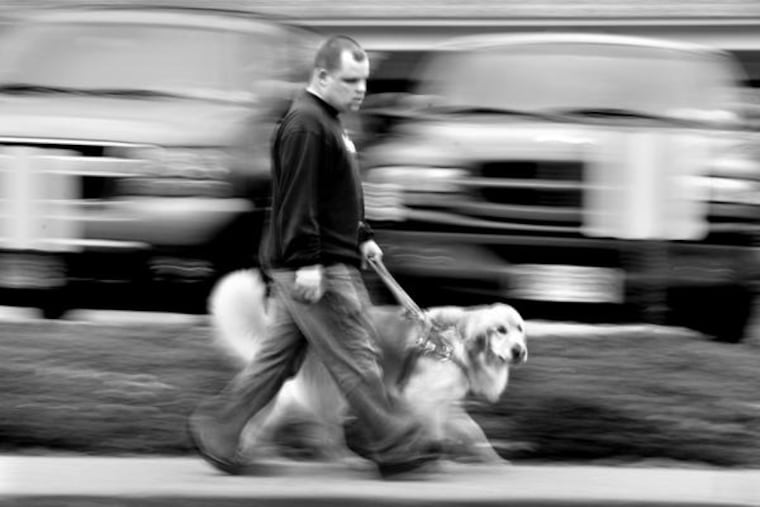Blind lawyer bonds with new Seeing Eye dog
The fledgling Philadelphia lawyer firmly issued a command, then strode confidently across a bustling city intersection, holding tightly to his new lifeline: "a big ball of fluff."

The fledgling Philadelphia lawyer firmly issued a command, then strode confidently across a bustling city intersection, holding tightly to his new lifeline: "a big ball of fluff."
Paul Sullivan, 25, an East Falls resident who has been blind since birth, was completing a training program at the Seeing Eye in Morristown, N.J., the world's oldest dog guide school.
For Sullivan, acquiring his new canine companion, a regal golden retriever named Bravo, was bittersweet. Sullivan lost his first guide dog, Edward, when he was hit by a car on Memorial Day - weeks before Sullivan was scheduled to take the bar exam.
Sullivan was 16 when he traveled to the Seeing Eye the first time to acquire Edward, a black Lab. He said he could not have completed his studies at Florida State University and Temple University's Beasley School of Law without the mobility that Edward provided.
When Sullivan learned in October that he had passed the bar, even that welcome news was tinged with the sadness of Edward's loss. Despite his grief, Sullivan said he knew he needed to proceed with plans to replace Edward.
Pete Jackson, a senior instructor at the Seeing Eye, said the intensity of the bond that forms between the dogs and their owners "goes beyond most marriages."
"It's a perfectly symbiotic relationship," said Jackson, one of five instructors in this month's training session. "The owners have the food and shelter; the dogs have the eyes."
Just by coincidence, Jackson, who had been Sullivan's instructor when he acquired Edward, was assigned to help Sullivan and Bravo forge a relationship. On the last full day of the training session, as Sullivan and Bravo traversed downtown Morristown, Jackson deliberately lagged a half-block behind.
"I don't want the dog to be distracted by me," Jackson explained. "They need to focus on each other."
Even with Jackson in the background, other distractions surfaced: A makeshift pedestrian walkway at a construction site initially confused Bravo before he proceeded through it, and a gaggle of cooing preschoolers had to be restrained from petting him.
"The dog's working," cautioned the woman shepherding them.
Jackson said he was pleased she understood the dog's role.
"There's something about a trained dog that is magnetic," he said.
Jackson should know. He has worked at the Seeing Eye for 35 years, getting pulled back to part-time after retiring.
He said people should always ask permission before touching a guide dog. Otherwise, the owner does not know that the dog's attention is elsewhere, creating an annoyance, if not a safety risk.
Sullivan and 21 other students in his class lived at the Seeing Eye with their dogs for two and a half or three and a half weeks, depending on whether they were acquiring a new dog or a replacement, Jackson said.
The students participated in daily training exercises, including a trip to New York City. Before being matched with Sullivan, Bravo, who will be 3 in May, received four months of training, Jackson said.
"The dog's job is to go to the end of the block, stop, and wait for the next command," said Jackson. "The owner's responsibility is to establish the route."
Both work extremely hard, he said, adding that not everyone realizes the owner has a burden, too, and must be constantly alert to changes in the dog. For instance, a sudden sway of the dog's head might be caused by a squirrel or something blowing in the wind.
"You become conditioned to the dog's responses," he said.
The dogs - all Labrador retrievers, golden retrievers, German shepherds, or a Lab/golden cross - are raised for the Seeing Eye, said Bonnie Lannom, a Seeing Eye communications associate.
Litters are identified by a letter of the alphabet, and the puppies in that litter all receive names starting with that letter, Lannom said. Groups that contribute more than $5,000 earn naming rights; otherwise, an administrative assistant gets the job.
The Seeing Eye, which has trademarked that label, has 1,800 active graduates worldwide, said Lannom. The organization has made 15,000 matches since 1929, she said.
According to the Web site for the American Foundation for the Blind, more than 7,000 Americans use dog guides, from Seeing Eye or other programs. Annually, approximately 1,500 individuals graduate from a dog-guide user program, the Web site said.
Jackson said Seeing Eye dogs are matched with students after a detailed assessment that includes home visits.
"We need to get a sense of what they'll be doing," Jackson said.
Students are also observed doing "test-walking" without a dog to study their paces and the way they would handle the harness.
"Then we divvy 'em up," said Jackson of the dogs.
Sullivan said he imagined a spirited "dog draft."
"In the first round, Pete Jackson picks Bravo," Sullivan joked.
He said he believed Bravo had been chosen wisely for him.
"He's going to be fine," Sullivan said, patting Bravo's head and calling him "a 61-pound ball of fluff."
Sullivan, who is looking for a job, said he hopes Bravo will be his "ace in the hole."
He said it would be perfectly fine if a law firm selected him after concluding: "We just have to have this dog in the office every day."